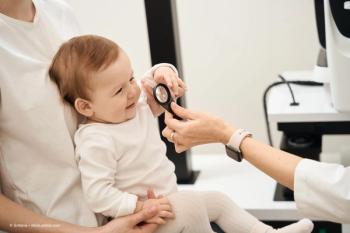
SOE 2023: A mixed method study of geographic atrophy
Video transcript
Editor’s note: This transcript has been edited for clarity.
David Hutton: Hi. I'm David Hutton of Ophthalmology Times. We are covering the European Society of Ophthalmology Congress being held in Prague. I'm joined today by Dr. Christiana Dinah, who will make a presentation titled "Geographic Atrophy: A Mixed Method Study." Thank you so much for joining us. Tell us about your presentation.
Christiana Dinah, MD: Thank you so much for having me. So we're excited to be presenting the work we've done on geographic atrophy over the last couple of years. Most people know that geographic atrophy is an advanced form of dry macular degeneration. and just as prevalent as wet AMD but slowly progressing, and up until recently, we've had no approved treatments for this cause of irreversible blindness. Very recently, in February, we've had the approval by the FDA of pegcetacoplan, or the brand name is SYFOVRE, which is basically monthly injections, or every other month injections, of a complement inhibitor. Which has been demonstrated to reduce the growth of geographic atrophy lesions by just over 20%. However, what our group wanted to demonstrate was to understand how acceptable these treatments, not just pegcetacoplan but any complement inhibitor delivered by intravitual injections – how acceptable are they to our patients. And this is because acceptability has been recommended to be a very key part of understanding whether patients will be adherent to treatment, once It's approved. Whether there'll be good uptake, and whether you know the treatment will be acceptable, just in general.
So we felt that it was an important aspect that had not been investigated previously. So what we did was we basically conducted in-depth, semi-structured interviews, as well as Likert scale type questions of patients with geographic atrophy – 30 of them. And we use a very robust framework called a theoretical framework of acceptability, which is broken down into – it breaks down acceptability into 7 different constructs to try to understand what are the factors of these treatments that patients find acceptable and what are the factors or measures within this treatment that might need to be improved to improve uptake, adherence and general acceptability for our patients.
David Hutton: What's the next step for this research?
Christiana Dinah, MD: Well, what we found in our study was that we – like I said, we have 30 patients. The main headline is that 60% of patients found the treatment acceptable, and would take the treatment once available to them. The others found the – I think, 27% – found the treatments, they were a bit ambivalent, they were unsure. And 13% found the treatment unacceptable, and didn't feel like they would accept the treatment if it became acceptable. So what we did was we tried to understand what factors contributed to this acceptability for patients. And in broad terms, we could group these factors into 3. There was logistics, so some of our patients felt that what it would take for them to attend these visits every month, or every other month, was a significant opportunity cost.
There was the risk of wet macular degeneration, which, even though small is increased, compared to not having any treatment. And these patients were worried that over in the past, they had been told or educated, the wet macular degeneration is bad and dry macular degeneration or geographic atrophy is good because it's slow. And so there's that sort of confusion around why they would receive a treatment that might increase their risk of getting the bad one, so to speak. And then there was the final factor was that some patients felt that the benefit was not as much as they would like, given the effort that will be required on their part to partake in the treatment. So our next steps, basically, is to take all that we've learned over the the 2 years of conducting this work – over 50 hours of interviews and analysis.
We've used that now to create a validated questionnaire, quantitative questionnaire, that we're now applying across the United Kingdom to approximately 200 patients to better be able to measure acceptability in a more generalizable population. And the reason we think this is important is we know that these treatments are coming. One has already been approved, but there's many others in the pipeline. And it will be really useful to be able to understand the factors that will influence adherence, but also to be able to potentially counsel patients with with regards to the risks and benefits of treatment, so that some of that counseling potentially could happen in the community using our tool which validated and then those who will find the treatment acceptable can be referred into hospital centers for ongoing treatment.
So there's a lot of potential for for this work, but mainly it helps us to understand from the patient perspective, their hopes and dreams, and also, what we can do to ensure that interventions are developed in a patient centered manner.
Newsletter
Keep your retina practice on the forefront—subscribe for expert analysis and emerging trends in retinal disease management.















































